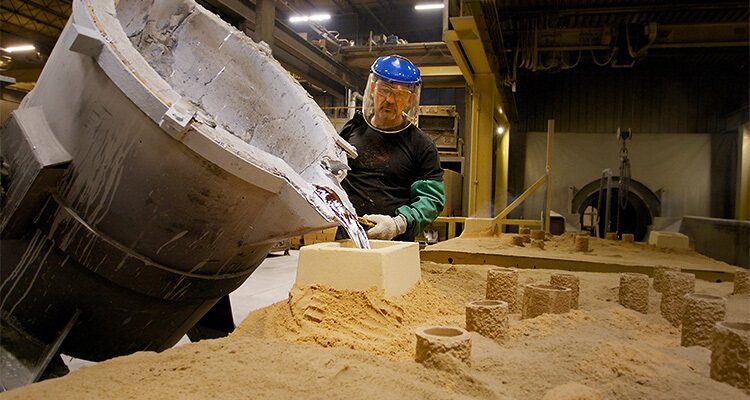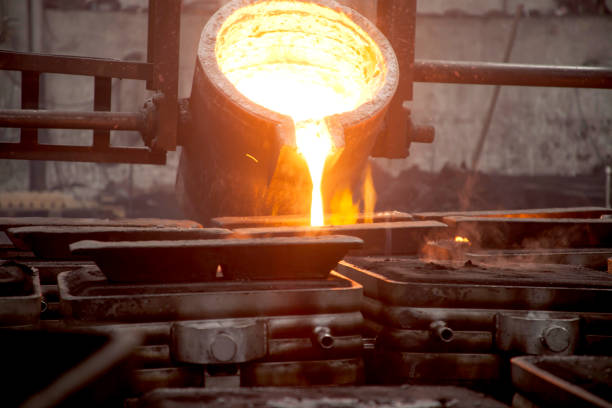Understanding Aluminum Castings vs. Other Metal Materials in Industrial Use
Wiki Article

Understanding the Refine: Just How Aluminum Foundries Produce High-Quality Products
Aluminum foundries play a vital function in producing high-grade items through a meticulous procedure. It starts with melting raw aluminum, which eliminates impurities. Later, different molding techniques form the metal right into preferred forms. Accuracy during putting and solidification is vital to meet specific specs. The last phases involve completing touches that improve resilience and look. As innovation advancements, these procedures are refined better. What developments are forming the future of aluminum foundries?The Melting Process: Transforming Raw Aluminum
The melting procedure works as an essential action in changing raw aluminum into functional items. Aluminum scrap or raw ingots are placed in a heating system where they are subjected to high temperature levels, usually getting to around 660 degrees Celsius. This intense warmth causes the aluminum to melt, permitting impurities to increase to the surface area, where they can be skimmed.Various melting methods, such as induction melting or gas-fired melting, might be used depending on the certain needs of the foundry. The option of approach can affect energy effectiveness and steel top quality. Maintaining exact temperature level control is vital to ensure consistent melting and to avoid oxidation that can compromise the product.
As soon as thawed, the aluminum is ready for additional handling, establishing the stage for subsequent operations that will certainly mold and mildew it right into particular forms and items. Aluminum Castings. The quality of the melting process directly influences the integrity of the final aluminum items produced
Molding Methods: Shaping the Future
After the aluminum has been melted and impurities got rid of, it is prepared for shaping via numerous molding strategies. One of one of the most widespread approaches is sand spreading, where a mold is created from sand and a binder. This strategy permits complex designs and is affordable for reduced to tool production runs. An additional prominent method is die spreading, which involves compeling liquified aluminum into a steel mold and mildew under high pressure. This strategy leads to high precision and smooth surface areas, making it optimal for automation.
Irreversible mold casting is additionally used, using recyclable molds that improve dimensional precision and surface coating. Each molding technique supplies distinct benefits, enabling foundries to customize their processes based upon product specs and production volume. By selecting the proper method, aluminum foundries can ensure superior quality and efficiency in their final products, strengthening their role in numerous industries.
Pouring and Solidification: The Art of Casting
Putting molten aluminum right into molds notes an important stage in the casting procedure, where accuracy and timing are vital - Aluminum Foundry. The shop team need to carefully manage the temperature level of the aluminum to guarantee suitable fluidness, avoiding flaws such as porosity or cool shuts. As the metal is put, it moves into the ins and outs of the mold and mildew, filling every dental caries to create the preferred formSolidification begins quickly as the liquified aluminum cools and alters to a strong state. This stage is influenced by a number of aspects, consisting of the mold product, density, and ambient temperature. The cooling rate has to be managed to avoid anxiety cracks or bending in the ended up item.
Once solidified, the aluminum handles the specific measurements and characteristics of the mold, setting the phase for subsequent processing. This pouring and solidification process exhibits the fragile equilibrium of art and scientific research in aluminum spreading, important for creating high-grade items.
Finishing Touches: Making Certain Quality and Precision
Ensuring quality and accuracy in aluminum items calls for thorough interest to detail during the ending up procedure. This stage includes different techniques targeted at boosting the surface area attributes and dimensional accuracy of the actors parts. Typical methods consist of machining, surface area treatment, and sprucing up. Machining remedies any type of dimensional discrepancies and attains the wanted tolerances, while surface area therapies, such as anodizing or powder finishing, provide deterioration resistance and enhance aesthetic allure.Polishing removes surface area flaws, causing a smooth surface that meets rigorous specs. Quality control is extremely important; each finished piece goes through rigorous examination to determine any kind of flaws. Advanced measuring devices, like coordinate measuring makers (CMM), are frequently used to ensure conformity with design requirements. Additionally, knowledgeable service technicians play an essential function, bringing experience and knowledge to recognize issues that makers may neglect. This thorough completing procedure ultimately guarantees that the aluminum items meet client assumptions for quality and performance.
Technologies in Aluminum Foundry Technology
The quest of high quality and accuracy in aluminum products has caused substantial advancements in factory modern technology. Innovations such as robotic automation have streamlined procedures, boosting performance and decreasing human error. These robotics are currently with the ability of performing complex tasks, including exact mold and mildew handling and product pouring, which guarantees consistent product high quality.On top of that, the assimilation of computer system mathematical control (CNC) equipments has revolutionized machining operations, permitting complex styles and tighter tolerances. Advanced simulation software application promotes far better procedure preparation by maximizing and forecasting prospective issues metal circulation. Furthermore, the fostering of eco-friendly techniques, such as hop over to these guys reusing aluminum scrap and making use of low-emission heating systems, has enhanced sustainability in the industry.

Frequently Asked Inquiries
What Kinds Of Aluminum Alloys Are Generally Utilized in Foundries?
Generally utilized aluminum alloys in foundries consist of 356, 319, and 413. These alloys are understood for their excellent spreading homes, mechanical toughness, and resistance to rust, making them suitable for a vast array of applications.Just How Do Foundries Make Certain Ecological Sustainability in Their Processes?
Shops execute ecological sustainability by recycling aluminum scrap, enhancing power efficiency, lowering emissions, using environmentally friendly products, and sticking to regulatory requirements, therefore reducing their eco-friendly footprint while maintaining manufacturing top quality and efficiency.What Precaution Are Executed in Aluminum Foundries?
Aluminum foundries carry out numerous safety steps, consisting of individual safety equipment, ventilation systems, routine safety and security training, emergency situation response protocols, and devices upkeep checks. These techniques intend to minimize hazards and ensure the wellness of all employees included.Just How Do Shops Handle Defects in Cast Products?
Foundries deal with flaws in actors items by utilizing extensive important site assessment strategies, consisting of aesthetic checks and non-destructive screening. When issues are recognized, they might revamp or junk items, making certain adherence to top quality criteria and consumer requirements.What Is the Regular Preparation for Aluminum Spreading Projects?
The normal lead time for aluminum casting projects ranges from a couple of weeks to numerous months. Aspects affecting this timeline include design complexity, manufacturing quantity, and the schedule of materials, which vary considerably across various foundries.Aluminum foundries play an essential role in creating top quality products with a thorough procedure. Wisconsin Aluminum Foundry. The shop group should carefully regulate the temperature level of the aluminum to assure suitable fluidness, avoiding issues such as porosity or cool shuts. The quest of high quality and accuracy in aluminum items has led to significant advancements in factory technology. Typically utilized aluminum alloys in foundries consist read this of 356, 319, and 413. Aluminum foundries implement different safety and security procedures, including personal safety tools, ventilation systems, normal safety and security training, emergency situation action methods, and equipment maintenance checks
Report this wiki page